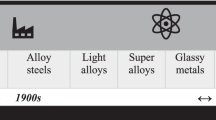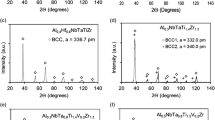Abstract
Theoretical studies have been carried out to examine hydrogen storage in some binary transition metal alloys which include titanium as one of the alloying elements. Quantum mechanical calculations at the Extended Hückel level of approximation have been performed on numerous clusters of compositions Ti18Ni18, Ti18Ni18H, Ti18Ni18H12, Ti24Ni12, Ti24Ni12H, Ti24Ni12Hi12, Ti16Cu16, Ti16Cu16H, Ti24Cu2, Ti16Fe16, Ti16Fe16H9, and Ti16Fe16H32, to yield information on energetics, densities of states, charge distributions, and the effects of hydrogenation on these properties. In addition, ab initio calculations at the split valence level of approximation have been performed on several smaller clusters. The hydrogens have been shown to acquire a partially anionic character in all cases. Another conclusion is that the preference of H for certain types of sites (for example the tetrahedral Ti4 sites in crystalline TiCu) is more likely to be related not to the intrinsically greater stability of a hydrogen atom located in such a site, but to more general topological and electronic considerations. Qualitative concepts related to the classification, spatial distribution, and sizes and shapes of “hole” sites which could become occupied by hydrogen atoms, have been shown to correlate with hydrogen storage capacity for crystalline materials. These qualitative concepts have been extended to amorphous materials and corroborate the observations that under optimized conditions amorphous alloys can be found with better reversible hydrogen storage properties than the crystalline or microcrystalline systems. Distorted tetrahedral and octahedral holes have been examined in detail, and parameters (volume, area, “tetrahedrality”, and “octahedrality”) have been introduced to describe their sizes and shapes. An algorithmic surveying technique has been introduced, and shown to provide useful information about the limiting amounts of hydrogen uptake.
Similar content being viewed by others
References
Ovshinsky SR et al., to be published (also see [32])
For an excellent recent review (with 161 references) of the properties and applications of metal hydrides in energy conversion systems, see: Wenzl H (1982) Int Metals Rev, 27:140–168
Papaconstantopoulos DA, McCaffrey JW, Nagel DJ (1973) J Phys F: Met Phys 3:L26
Papaconstantopoulos DA (1973) Phys Rev Lett 31:1050
Kallne E (1974) J Phys F: Met Phys 4:167
Switendick AC (1978) In: Alefeld G, Volkl J (eds) Hydrogen in metals I. Springer, Berlin p 101
Switendick AC (1978) Transition metal hydrides. Advances in Chemistry Series 167:264–282
Switendick AC (1979) Z Phys Chem NF 117:89
Switendick AC (1980) J Less-Common Met 74:199
Gupta M, Burger JP (1981) Phys Rev B 24:7099
Keller J, Castro M, de Paoli AL (1982) J Appl Phys 53:8850
Gupta M (1982) Phys Lett 88A:469
Gupta M (1982) J Phys F: Met Phys 12:L57
Boletskaya TK, Egorushkin BE, Fadin VP (1982) Phys Stat Sol B 113:307
Papaconstantopoulos DA, Kamm GN, Poulopoulos PN (1982) Solid State Commun 41:93
Peterman DJ, Misemer DK, Weaver JH, Peterson DT (1983) Phys Rev B 27:799
Chan CT, Louie SG (1983) ibid 27:3325
Griessen R (1983) ibid 27:7575
Ho KM, Tao HJ, Zhu XY (1984) Phys Rev Lett 53:1586
Fukai Y (1984) J Less-Common Met 101:1
Wicke E (1984) ibid 101:17
Gupta M (1984) ibid 101:35
Switendick AC (1984) ibid 101:191
Vaks VG, Zein NE, Orlov VG, Zinenko VI (1984) ibid 101:493
Griessen R, Driessen A (1984) Phys Rev B 30:4372
Rao BK, Jena P (1985) Phys Rev B 31:6726
Messmer RP, Salahub DR, Johnson KH, Yang CY (1977) Chem Phys Lett 51:84
Upton TH (1984) J Am Chem Soc 106:1561
Johnson JR, Reilly JJ (1978) Inorg Chem 17:3103
Cotts RM In: Hydrogen in metals I, Ref. 3d
Flotow HE (1979) Z Phys Chem NF 116:95
Weaver JH, Peterson DT (1980) J Less-Common Met 74:207
Schlapbach L, Scherrer HR (1982) Solid State Commun 41:893
Bowman RC Jr, Maeland AJ, Rhim WK (1982) Phys Rev B 26:6362
Saw CK, Beaudry BJ, Stassis C (1983) ibid 27: 7013
Bohmhammel K, Wolf G, Mädge H (1984) J Less-Common Met 101:239
Ref. 3n also presents experimental results
Hoffmann R (1963) J Chem Phys 39:1397
Hoffmann R, Lipscomb WN Jr (1962) ibid 36:2179 and 3479; and ibid 37:2872; for some recent applications to solids, see:
Whangbo MH, Hoffmann R (1978) J Am Chem Soc 100:6093
Hughbanks T, Hoffmann R (1983) ibid 105:1150 and 3528
Hoffmann R, Hughbanks T, Kertesz M, Bird PH (1983) ibid 105:4831
See Ref. 3e for a discussion of TiH2 and PdH, and 4g for a discussion of the deuterated system ScDx
For an excellent recent review of the concepts involved in the question of site occupancy, and of numerous other methods addressing related problems, see Westlake DG (1983) J Less-Common Met 91:1
Binkley JS, Whiteside RA, Krishnan R, Seeger R, DeFrees DJ, Schlegel HB, Topiol S, Kahn RL, Pople JA (1980) QCPE 13:406
Pietro WJ, Hehre WJ (1983) J Comput Chem 4:241; instead of a 3spd shell, a 3sp and a 3d shell are used
Lohr LL Jr, Pyykkö P (1979) Chem Phys Lett 62:333
Howell J, Rossi A, Wallace D, Haraki K, Hoffmann R: QCPE Program No. 344
Veillard A, Demuynck J (1977) In: Schaefer III HF (ed) Modern theoretical chemistry vol 4. Plenum, New York, pp 187–222
Huzinaga S (1984) Gaussian basis sets for molecular calculations. Elsevier, New York
Krishnan R, Binkley JS, Seeger R, Pople JA (1980) J Chem Phys 72:650
Desclaux J-P (1973) At Data Nucl Data Tables 12:311
The original references are: Burns G (1964) J Chem Phys 41:1251 for the s and p orbitals
The original references are: Richardson JW, Nieuwpoort WC, Powell RR, Edgell WF (1962) ibid 36:1057
Pitzer KS (1979) Acc Chem Res 12:271
Pyykkö P, Desclaux J-P (1979) ibid 12:276
Baskes MI, Melius CF, Wilson WD (1981) In: Bernstein IM, Thompson AW (eds) Hydrogen effects in metals. Metallurgical Society of AIME, pp 67–75
Daw MS, Baskes MI (1983) Phys Rev Lett 50:1285
Hintermann A, Manninen M (1983) Phys Rev B 27:7262
Bagus PS, Schaefer III HF, Bauschlicher CW Jr (1983) J Chem Phys 78:1390
Pearson WB (1967) A handbook of lattice spacings and structure of metals and alloys vol 2. Pergamon Press, Oxford, for TiNi, TiCo and TiFe
Mueller MH, Knott HW (1963) Trans Met Soc of AIME 227:674, for Ti2Ni and Ti2Cu
Thompson P, Reilly JJ, Reidinger R, Hastings JM, Corliss LM (1979) J Phys F: Metal Phys 9:L61 for FeTiD2, assuming that the deuteriums can each be replaced by a hydrogen at the same position
Metals handbook (1973) Metallography, structures and phase diagrams, 8th edn vol. 8. American Society for metals, pp 237 and 239 for TiCu
Otsuka K, Sawamura T, Shimizu K (1971) Phys Stat Sol 5:457 for the monoclinic phase of TiNi
Buchner H, Gutjahr MA, Beccu KD, Saufferer H (1972) ZF Metallk 63:497
Lundin CE, Lynch FE, Magee CB (1977) J Less-Common Met 56:19
Handbook of chemistry and physics (1979) Weast RC, Astle MJ (eds) 60th edn CRC Press, p F-217
Bicerano J, Marynick DS, Lipscomb WN (1978) Inorg Chem 17:3443
For a parameterization widely used for organometallic species, see: Lauher JW, Hoffmann R (1976) J Am Chem Soc 98:1729
For a parameterization widely used for organometallic species, see: Summerville RH, Hoffmann R (1976) ibid 98:7240. When we attempted to use this parametrization for the binary transition metal alloy and hydride systems described in this paper, we obtained unreasonable results (preliminary calculations, results not listed).
Eastman DE (1972) Solid State Commun 10:933
Kittel C (1976) Introduction to solid state physics, 5th edition. Wiley, New York, chap 3, p 74, Table I
For example, the STO-3G calculations reported in Ref. 19 for the Be36 cluster yield CE(cluster)= 23 kcal/mol per atom. This leads to CE=41.4 kcal/ mol per atom after weighting by the ratio ¯C(bulk)/¯C(cluster)=12/62/3=1.8. This value is still much less than the 78 kcal/mol per atom CE of the bulk metal. (Stull DR, Prophet H (1979) JANAF thermochemical tables, 2nd edn. NSRDS-NBS 37. Superintendent of Documents, Washington, D.C.)
Allred AL (1961) J Inorg Nucl Chem 17:215
Ref. 22, Table II. Note that our definition is per H atom obtained by breaking up an H2, while their definition is per H2 molecule. Thus, our values are half of theirs. The conversion factor from kcal/mol to eV is 1/23.061
Mal HH van, Bushow KHJ, Miedema AR (1974) J Less-Common Met 35:65
Miedema AR, Boom R, DenBoer FR (1975) ibid 41:283
Bouten PC, Miedema AR (1980) ibid 71:147
Ovshinsky SR, Sapru K, Dec K, Hong KC (1984) U.S. Patent No. 4,431,561 (issued on February 14)
A considerable amount of work has been carried out to investigate the hole structure of computer models of non-crystalline materials. For example, see Popescu MA (1980) J Non-Cryst Solids 35, 36:549 for a discussion in terms of hole radius distributions and their relationships to some of the properties of amorphous materials
Ovshinsky SR (1985) In: Adler D, Schwartz BB, Steele MC (eds) Physical properties of amorphous materials. Institute for Amorphous Studies Series, vol 1. Plenum Press, New York, p 105
Ovshinsky SR (1985) J Non-Cryst Solids 75:161
For a comprehensive general review of the theory of the structures of non-crystalline (i.e., “amorphous”) solids, written especially for chemists, see Bicerano J, Adler D: Pure Appl Chem, in press
Ref. 23, pp F-222 and F-223
Author information
Authors and Affiliations
Additional information
Camille and Henry Dreyfus teacher-scholar
Rights and permissions
About this article
Cite this article
Bicerano, J., Keem, J.E. & Schlegel, H.B. Theoretical studies of hydrogen storage in binary Ti-Ni, Ti-Cu, and Ti-Fe alloys. Theoret. Chim. Acta 70, 265–296 (1986). https://doi.org/10.1007/BF00534235
Received:
Accepted:
Issue Date:
DOI: https://doi.org/10.1007/BF00534235




